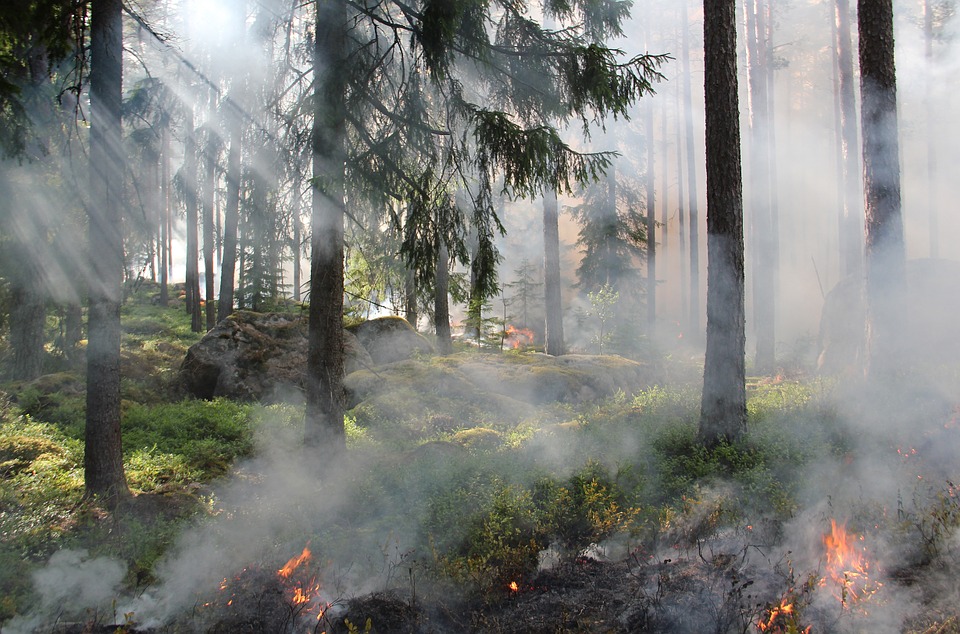Forest Service Should Have Managed Fuel, Officials Say
PUBLICATION: Goldendale Sentinel, WA print edition
The severity of the Cold Springs fire that has been raging near Trout Lake for almost two weeks might have been prevented with better forest management, officials said this week.
Agency heads lamented too much fuel was allowed to build up prior to the fire, which struck on U.S. Forest Service (FS) land on July 12.
If a more comprehensive plan had been in place, they said, it would not have reached the point it did last weekend, when trees became engulfed in flames and a plume of smoke shot 20,000 feet into the air, causing many spectators to think Mt. Adams had erupted.
“There is no debate that the forest was in a bad state of affairs up there from some of the decisions the Forest Service made and some of the decisions that were made for them,” said Frank Backus, chief forester for SDS Lumber, a company operating timber sales out of the region.
“It’s a long and convoluted mess and the end result is we’ve had a large fire…None of that needed to happen if good, solid forest management practices had been allowed to transpire,” said Backus.
However, Emily Platt, executive director of the Gifford Pinchot Taskforce, noted the fire has mostly burned at higher elevations. She said trees at that level are meant to burn in cycles and the event could be considered healthy for the forest.
Platt also noted how quickly officials responded to the fire and kept it out of certain areas.
“We definitely think it’s a good thing the fire burned there,” said Platt, noting the presence of Lodgepole pine trees at the higher elevations.
Forest Service officials were quick to add the agency kept structures and communities safe. Chris Strebig, a public information officer for the Forest Service, pointed to the 800 acres of land that had been treated leading up to the fire.
In a region as broad as the Gifford Pinchot, he said, areas must be prioritized in terms of which need management most direly. The region has been dealing with dead wood and leftover effects from an insect infestation for many years.
Moreover, the area has not yet been assessed for actual damage.
“It’s easy to say, ‘It would have done this or it wouldn’t have done that,’ but you have to go and look at what it actually did on the ground,” Strebig said. “I think now it’s too early to say.
“The initial reaction is to take a potshot at the different things that could have been done, but I hope it’s an opportunity to sit down and talk.”
Backus, however, was not the only official to voice concerns this week about forest management.
Jay McLaughlin, executive director for the Mt. Adams Resource Stewards (MARS) said that although he feels it is “unfair” to point fingers only at the Forest Service, the land was nevertheless in dire need of work.
“The way that the fire is burning now is way beyond the scope of how it would have burned naturally,” said McLaughlin. “It is indeed frustrating to see. We’ve been talking about the potential for this kind of event for years. It’s been obvious to anyone involved in forest management and the layperson as well.”
Nate Putnam, a forester with the Hancock Management Team, agreed.
“The Forest Service needs to be more aggressive in practicing forest management,” said Putnam. “I think they get too focused in on the microscopic level and lose sight of the bigger picture.”
One of the debates has been around a defoliator bug known as the Spruce budworm, which infected the forest years ago, leading to a lot of dead wood on the ground. The issue has surfaced most around the space known as the Gotchen Planning Area.
“The Forest [Service] knew the area obviously was bug-killed starting about 1985,” said Strebig. “It wasn’t just the Gifford Pinchot, it extended into the state and Yakama Nation.”
Officials have been working on planning documents for about 20,000 acres of land, he said. The idea has been to target people’s time and money on places that provide the most protection to communities.
Yet Putnam said at the time of the initial infestation, authorities did not spray against the insect because of the potential harm the herbicides might do to a threatened butterfly, known as the Mardon Skipper.
He said the case is an example of how the agency often overlooks broad-scope issues in favor of smaller details.
Backus agreed:
“Now it’s all burned up, including the butterfly and the spotted owl habitat,” said Backus. “You spray it now or you burn it later.”
However, Platt said it is an unfair assessment. Efforts to conserve the endangered butterfly habitat indeed succeeded, she said, albeit on a lengthened time scale.
She acknowledged a good deal of time was spent drafting plans, but once they were together, agencies began cleaning up the landing force and have been doing it ever since.
She said this approach has succeeded in managing land while maintaining wildlife habitat – a win-win situation. Moreover, she said, the area now burning is not in the zone they had wanted to spray anyway.
Peter Stocks, a representative for the Klickitat County district of the Washington Department of Natural Resources (DNR), pointed out, however, that losses from the fire are not limited to land and natural resources.
About 600 acres, he said, spread onto DNR trust land, which goes to funding schools. Now, about half of the trust land has been lost to the fire.
According to McLaughlin, a portion of a 2.7 million board foot harvest unit has likely been lost, although at this point it is unclear how much. He guessed it will be a small portion.
Beyond that, Stocks noted about $40,000 in losses to other planting efforts.
Although DNR had managed the land “intensively” through ongoing, small diameter slash burning, they have now been set back.
“Now we have to start from the beginning,” Stocks said.
At this point, DNR’s first move is to assess the soil to determine whether it is still viable for planting. He said fires can sometimes sterilize soil and sap nutrients for immediate future growth.
Stocks also noted the agency is on watch for hard rains that might wash ash and char into nearby streams, contaminating aquatic habitats.
The Cold Springs fire, thought to have originally been caused by lightning, is now 85 percent contained, with 1,096 fire fighters and support personnel on the scene. The fire zone stretches for about 8,000 acres, with some spots of non-perished land in between.
Fire lines have completely encircled the area and, according to officials, the only threat of spread would be if embers were blown across those lines. To minimize that chance, crews have been working to burn out interior islands of fuel.
Officials have tentatively slated Friday, July 25, to hand off the response to a local unit. They have set August 1, as an estimated total containment date. The growth potential is still listed as “high.”
Meanwhile, a fire that began Sunday near Big Lava Bed southwest of Trout Lake has burned about eight acres and a separate, five-acre fire north of Mt. Adams near Sheep Lake has six personnel on the scene.
McLaughlin said the key to future forest plan success hinges on “engaging policy makers” and maintaining transparency for public trust. With some work, he said, policies can be created that will facilitate “quicker, more responsive action.”
“To make that happen it will take funding, it will take political support, public support and cooperation,” McLaughlin said.
Strebig said different agencies must also come together to balance different interests.
“Everybody wants a healthy forest that will allow a steady flow of timber sales, that will allow recreational opportunities.” said Strebig. “We are hoping [the fire] provides an opportunity for people to…get down and talk with us and figure out what’s the next step – what’s the common ground.”
“There is a huge opportunity for that kind of collaboration,” added Platt. “Hopefully, this can be an incentive.”
This article was originally published in the Goldendale Sentinel newspaper. Goldendale, Washington. Photo with permission from Pixabay.








